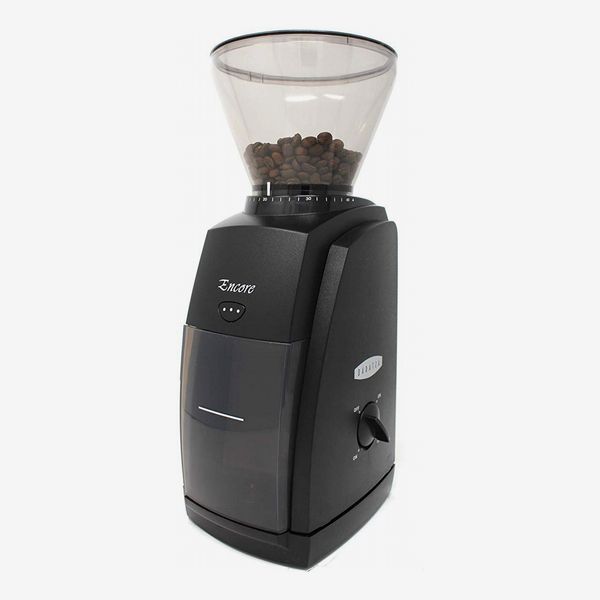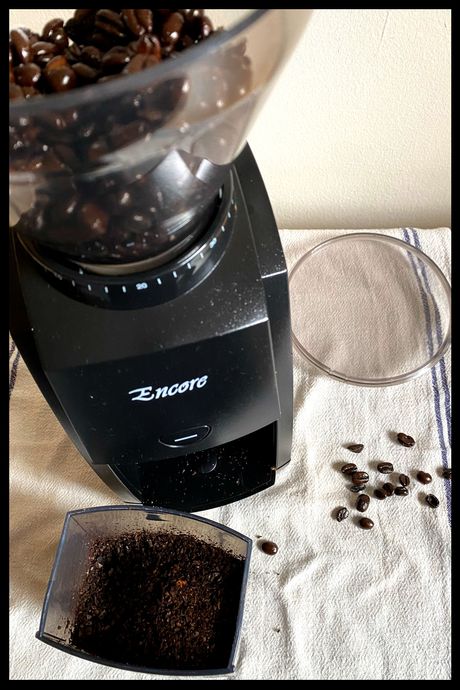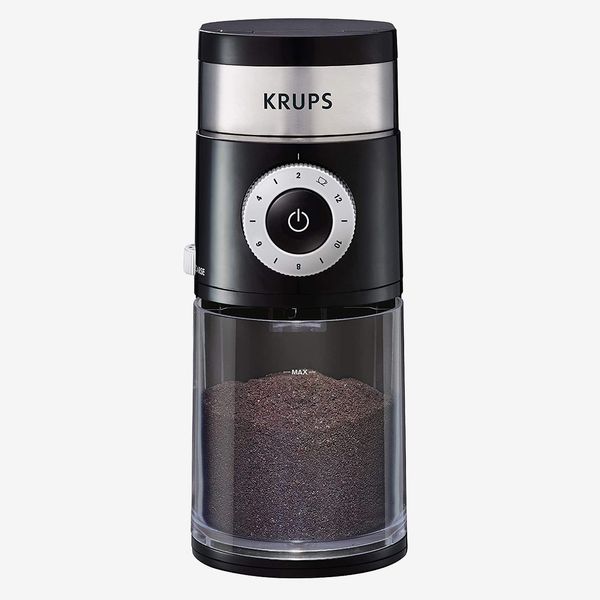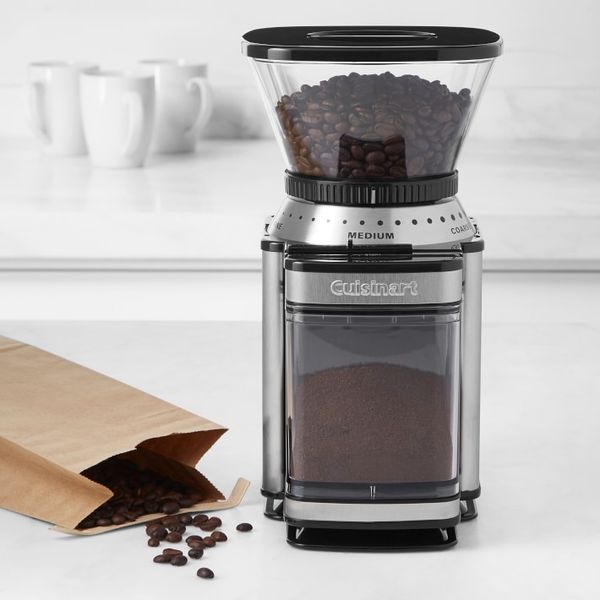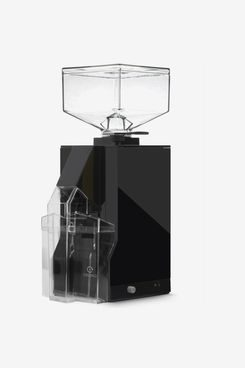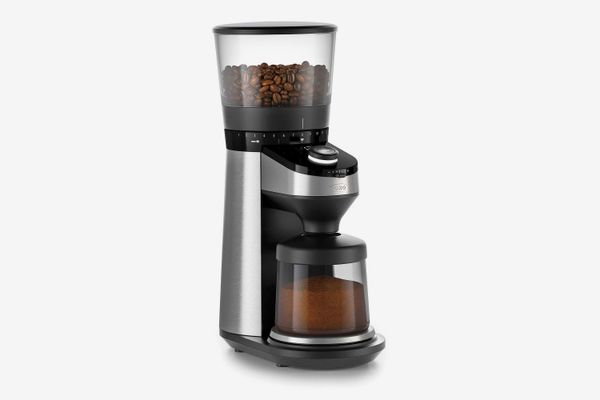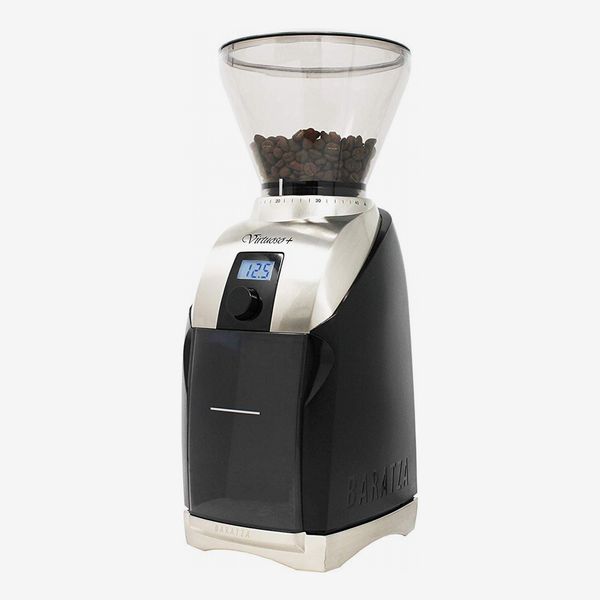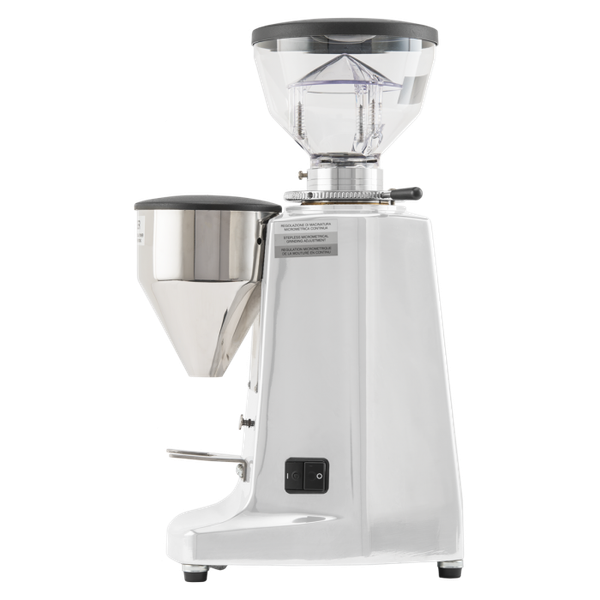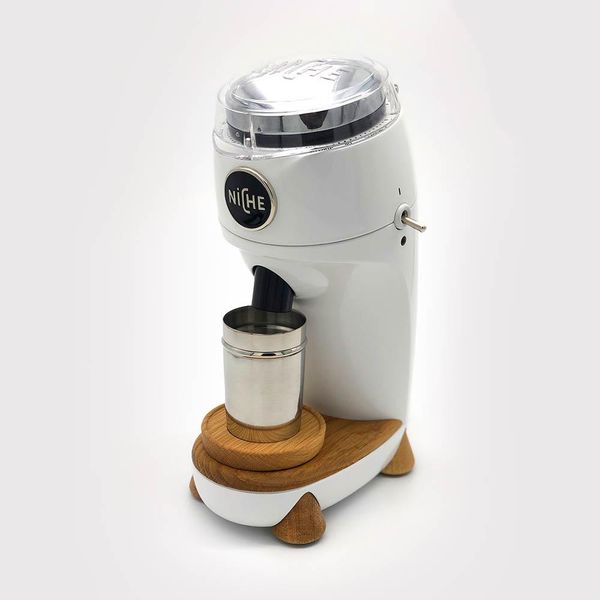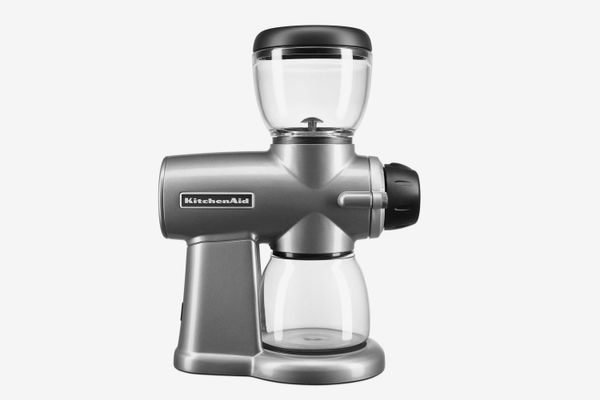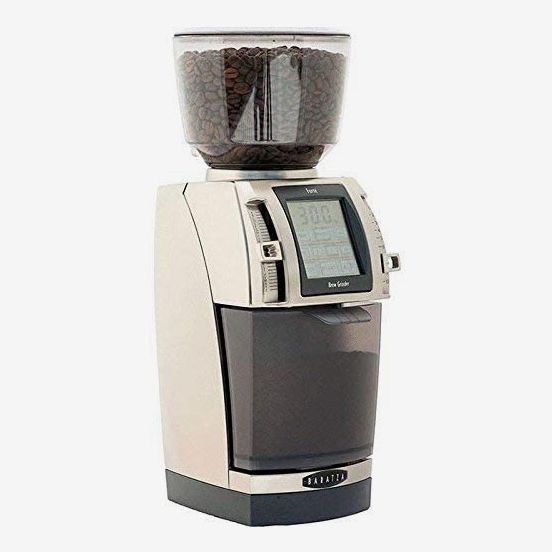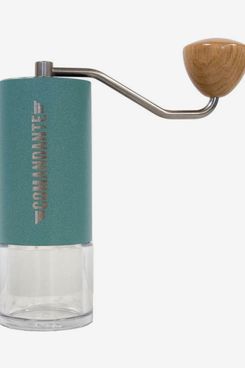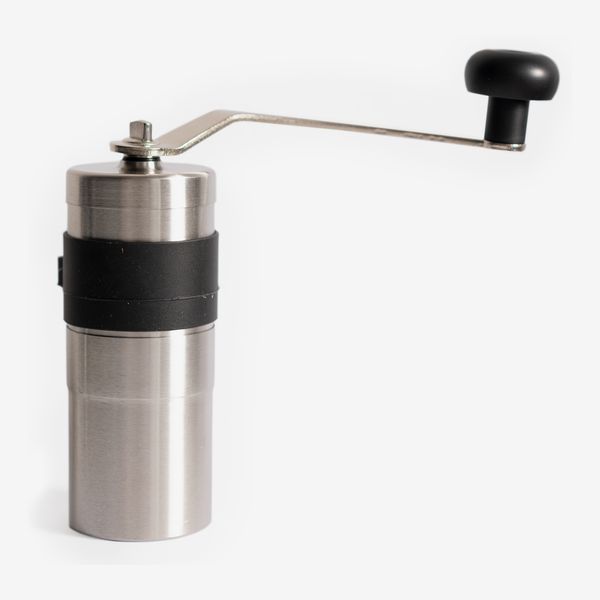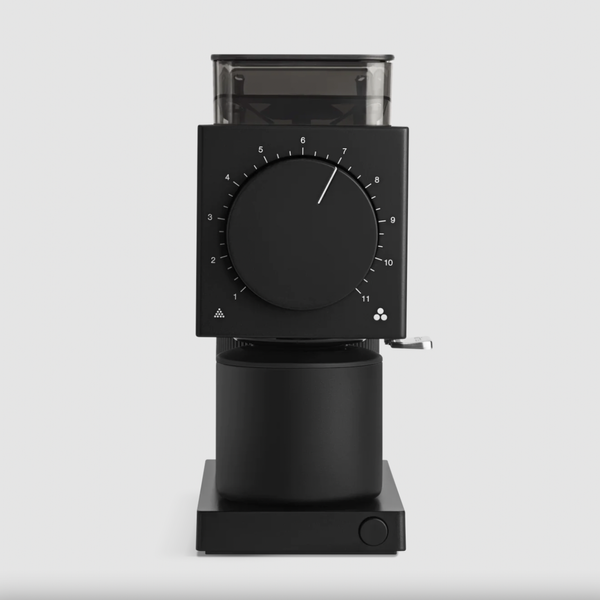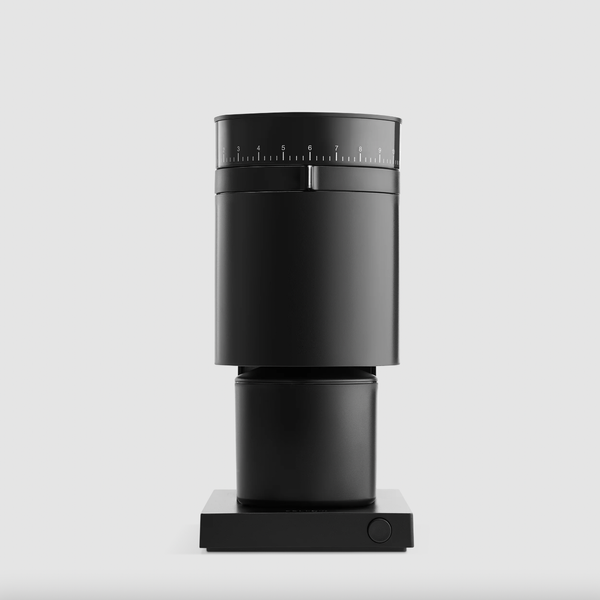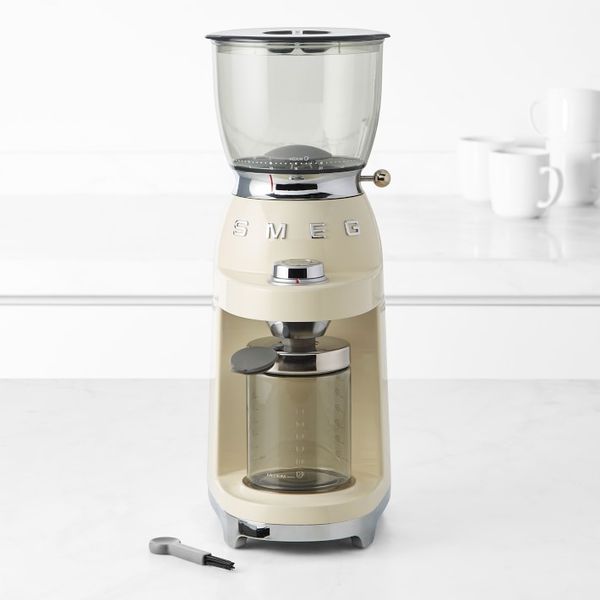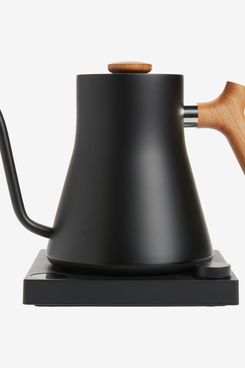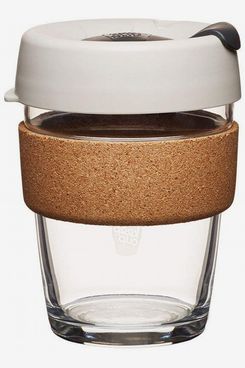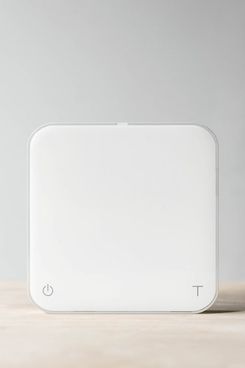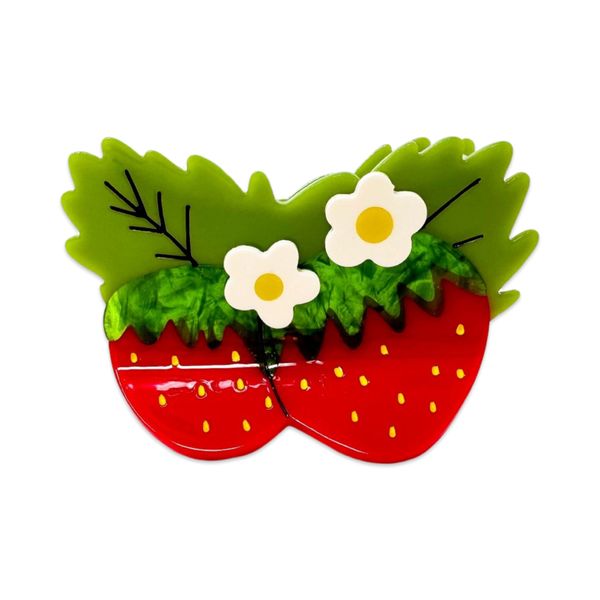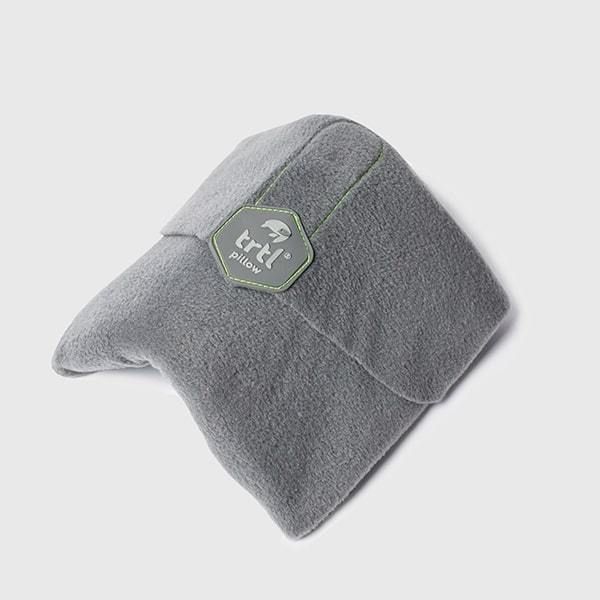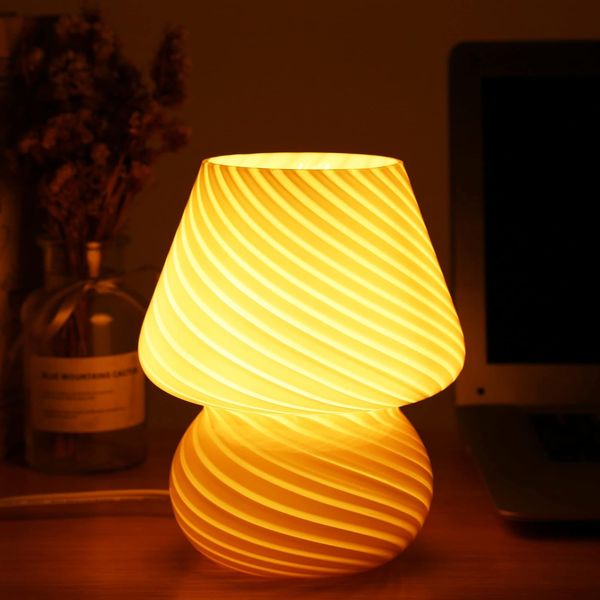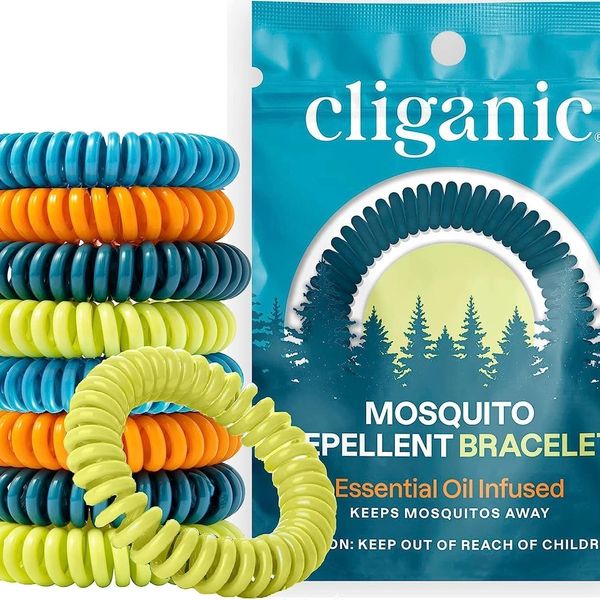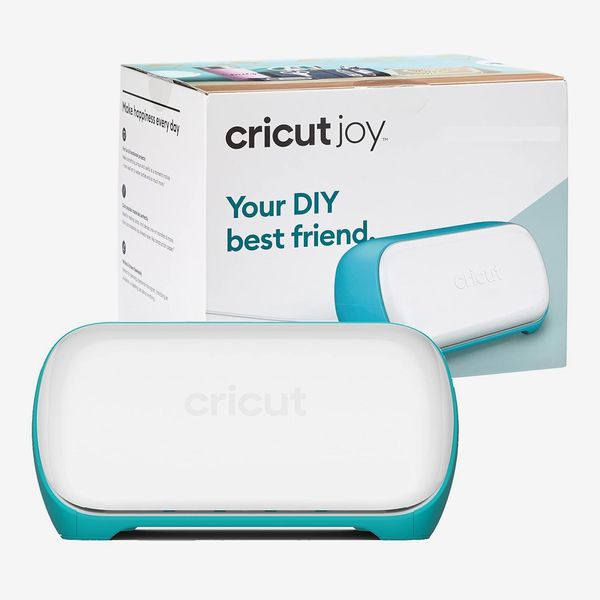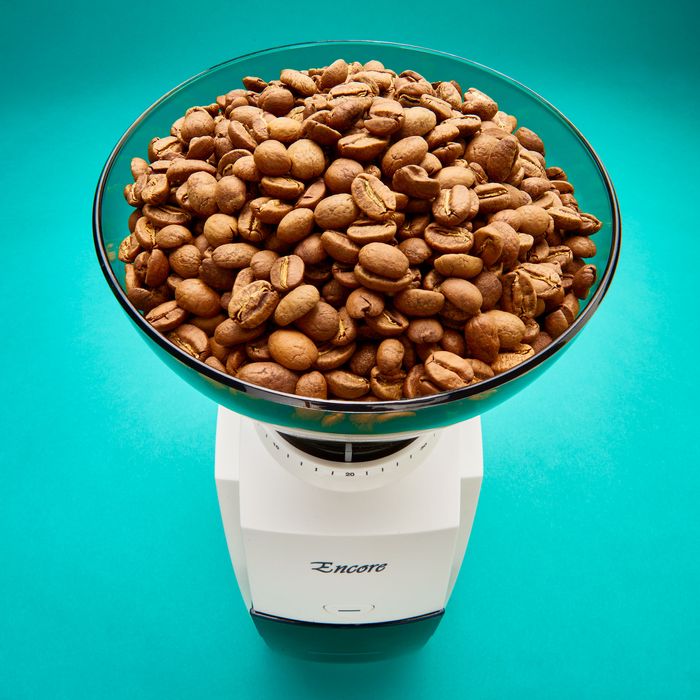
In this article
I’ll be honest: I’m not a coffee snob. Give me a cup — pretty much any old cup — and I won’t complain. However, that doesn’t mean I don’t appreciate a particularly good one. And as any actual coffee snob will tell you (trust me, I’ve talked with a lot of them), your coffee is only going to be as good as your beans. And your beans won’t be any good at all if you’re not grinding them yourself right before brewing.
Unfortunately, most decent coffee grinders — even those made specifically for home use — cost a very pretty penny. We’re talking hundreds of dollars. So to figure out which models are worth the investment, I tested some out myself, including the (relatively) mid-priced model that ultimately won a permanent spot in my kitchen and, therefore, our best overall badge. I also asked baristas, roasters, and coffee shop owners about the versions they keep on their own counters. Some are predictably very high-end (so if you’re a coffee fanatic looking to hone your skills, you’ve come to the right place), but others are surprisingly reasonable given the landscape of the market. And if you’re still not quite convinced a coffee grinder is something you should put so much hard-earned money towards (ahem, me), don’t worry: I also tapped a few other Strategist writers and regular home cooks with a caffeine habit to find out their even more affordable picks. And if you’re shopping for a whole new setup, you can read my guides to the best coffee makers, electric kettles, espresso machines, and milk frothers.
What we’re looking for
Blade style
Every expert I spoke to noted that burr grinders (which break down beans in a kind of milling action) are better than blade grinders (which act more like choppers). As someone who has a barely used blade grinder sitting shamefully in the back of a cabinet, I concur. Will Pratt, owner and founder of Tandem Coffee Roasters in Portland, Maine, explains that with burr grinders, all the beans pass from the top of the machine to the bottom, meaning they end up a uniform and precise size, as opposed to getting “thrown around like they’re in the dryer.” Joanna Lareau, cafe manager at Stumptown Coffee, agrees that blades are a haphazard method, leaving you with some coffee that’s “over-extracted” (quite bitter) and some that’s “under-extracted” (quite sour). Plus, she says, “with burr grinders, you can tinker until you find what tastes good” for whatever coffee maker you use.
Noise level
Whether it’s at your own pre-coffee expense, or your sleeping partner or roommate’s expense, early morning noise is pretty universally unwelcome. Almost every grinder makes some, but we categorized each as either “loud” or “quiet” depending on which way it leaned — and went into more detail in the description of each.
Price
As noted above, these aren’t cheap. But with coffee grinders, cost is relative, denoted by the number of dollar signs. $ means it costs less than $100, $$ means between $100 and $400, $$$ between $400 and $800, and $$$$ above $800.
Best coffee grinder overall
Blade style: Burr | Noise level: Loud | Price: $$
I’ve been using the Baratza Encore for a year now and I love it (it’s one of the tools that has convinced me to up my at-home coffee game). The machine is super intuitive to use, and initially took me no more than five minutes to set up and get a handle of. There are two simple switches — on and off — and a dial to set the grind size between 0 and 40. Mine generally stays between 25 and 30 to work with my standard coffee machine, but I’ve used the smallest setting for espresso (notoriously difficult to get as fine of a grind as you need) with no problem. And the subtleties between all the sizes are very apparent: You can make minute adjustments if you’re dedicated to landing on exactly what will yield the best cup for your particular coffee-brewing method. It takes a couple of rounds to grind a full bag of beans (how I do it, as opposed to per serving), but works quickly at about a minute per turn. In general, my biggest qualm with coffee grinders is the mess they make, but this one has nicely angled sides on the grind chamber that allow for relatively neat pouring. And it’s easy to disassemble, clean, and reassemble the detachable parts before I store it.
As a brand, Baratza came up in my reporting more often than any other. Some favor its higher-end models (more on a couple of those below), but several of the coffee aficionados I spoke with recommended this more affordable option, highlighting its quality performance and solid build — especially for the price. “It’s super-consistent,” Lareau says. Elliott Foos, director of coffee at Daymoves in Brooklyn, told us that he used the Encore at work when he previously ran the coffee shop attached to the first iteration of chef Flynn McGarry’s Lower East Side restaurant Gem. “It’s intuitive and performs wonderfully,” he says. While he acknowledges it can be a little loud — or a “touch chatty,” in his words — Foos says that’s to be expected for a grinder made of plastic and designed for the home. And Humberto Ricardo, founder of Third Rail Coffee, adds that Baratza machines are “designed to be repaired instead of thrown away should something break, which is good for my wallet and for the planet.” And speaking of repairs, Pratt noted Baratza’s great customer service. “When you have to replace the burrs every few years, they make it incredibly easy to do so,” he says.
Best less expensive coffee grinder
Blade style: Burr | Noise level: Quiet | Price: $
If you’re not quite ready to take the plunge on a model upwards of $100, the Krups Precision Grinder is a very solid place to start. It comes recommended by Paul Schlader, owner of New York City-based Birch Coffee, who promises it has the essentials: 12 settings for selecting your preferred grind size and a “cup selector” dial to grind the exact amount of coffee you need for the number of drinks you’re making — and that’s it. The simplicity is exactly what Strategist writer Jeremy Rellosa, who bought the machine about a year ago, likes about it. Previously, Rellosa used a hand-crank model that took too much work and a blade grinder that resulted in uneven ground size; the Krups, he says, solves both these problems, giving him “the ease of an electric machine and the consistency of a burr blade,” he says. Now, he says he makes great pour-over daily and never has to fidget with the grind setting or cup dial — he simply pours his beans in, turns it on, and walks away. “The appliance also comes with a tiny brush to get all the coffee unstuck from the plastic grounds container,” he says. “But if you keep it clean, I’ve found that you rarely have to use it (the bits just slide right off as you dump them into your filter).”
Best even less expensive coffee grinder
Blade style: Burr | Noise level: Loud | Price: $
Before I got my hands on the Baratza, this was the entry-level grinder I had for about a year, one of the most affordable on the market with burr-style blades. It’s quite intuitive to use: You simply fill the chamber with beans, set the dial to any of the 18 settings between fine and coarse grind, set the number of cups you are planning to brew (though you won’t need this if you pre-weigh the amount of beans you put in in the first place), and press start. And while I only used mine once a month or so (I sometimes buy pre-ground beans, and even more so back in the day), Strategist writer Erin Schwartz has used the same model nearly every day for more than five years and says “it’s kind of incredible that it hasn’t broken or shown any signs of serious wear and tear yet.” They like that the top container can fit a standard-size bag of beans so they don’t have to waste pantry space on leftovers. And while they note that it’s not the easiest to take apart to clean, most of the pieces are dishwasher-safe, and it stores well, retangular and compact with a place to wrap the cord underneath.
Best coffee grinder for filter brew methods
Blade style: Burr | Noise level: Quiet | Price: $$
Matthew Kang, editor of Eater L.A., likes the Eureka Mignon even more than the similarly priced Baratza because he says it has better grind consistency. The catch is that it only mills on the coarser end of the spectrum — meaning it’s great for methods like pour-over, French press, and Aeropress, but not espresso. But the grinder is “strong, durable, and powerful,” Kang says, breaking down whole bags of coffee at a time with its bigger-than-average 50-mm. flat burrs. Kang does note that the machine only has a small dial to change the grind setting and a tiny button on the bottom to start the grinder without any timers. But he says that doesn’t matter — in the end, “the beans will be ground more consistently, resulting in better-tasting coffee.” This grinder certainly makes some noise, but as you can see in this video, it’s quite a reasonable level — especially for this price point, as the pro testing it points out.
Best coffee grinder with an integrated scale
Blade style: Burr | Noise level: Loud | Price: $$
Schlader loves this Oxo grinder for a number of reasons, but chief among them is its “built-in intelligent scale” — which means you won’t lose extra money or counter space buying a separate one. The feature “simplifies the process of grinding coffee for your average home brewer and cuts down on equipment,” he says. Enter the number of cups you’re going to brew and your preferred coarseness for whatever coffee-making method you employ, and the grinder spits out exactly what you need. “It’s an incredibly thoughtful product,” he says.
If you’re interested in an Oxo grinder (we love so many of its kitchen products, after all) but don’t need an integrated scale, recipe developer and cookbook author Samah Dada recommends this model. (It’s $200 less than the above’s regular price.) “I’ve had other grinders that gave me grief with error messages for no reason or inconsistent grounds,” she says. But in the year and a half she’s owned it, she says “this one has not failed me yet” even with frequent (up to twice a day) use, during which it takes about 30 seconds to grind whole beans. She also says she appreciates that the hopper is UV-blocking (so leaving whole beans in there won’t age them) and that it comes off the top of the machine very easily to rinse clean.
Best coffee grinder with an integrated timer
Blade style: Burr | Noise level: Loud | Price: $$
If you’re looking for a grinder with a timer, four of our baristas praised this model. You can set it to grind for a specific time, turn it on, walk away, and return to beans that are never overground. (The Encore, by contrast, must be stopped and started manually.) Otherwise, it is a bit of a general step up from the Baratza Encore, too, with stronger blades that are able to get a slightly finer grind for espresso (you can see a good demonstration in this video). If one or both of those attributes appeal, I think it’s worth the extra $50. Ricardo also notes that it’s fast and relatively quiet.
Best coffee grinder for espresso
Blade style: Burr | Noise level: Loud | Price: $$$$
The grinder is on the pricier side, but according to Morrison, it’s worth it. “Most grinders claim they can get a fine-enough consistency for espresso,” he says, “but that’s just not true.” The Marzocco, on the other hand, was made specifically for espresso and espresso alone. And unlike the Niche Zero right below, you can fill the hopper with enough beans at a time to grind more than one dose, one right after the other. It’s high-quality enough to be used in many coffee shops but still a good investment at home if you’re a serious espresso drinker. “For espresso preparation, a mediocre grind is a nonstarter,” says Morrison.
Best less expensive coffee grinder for espresso
Blade style: Burr | Noise level: Quiet | Price: $$$
Several times a year, Cary Wong, a member of the Partners Coffee education team, attends trade shows to try lots of new products. This grinder left such a lasting impression that he still recommends it years later. The Niche Zero is a stepless grinder, which means you have infinite grind-size settings as opposed to having to choose from predetermined ones. That feature, Wong says, “really allows you to grind fine enough coffee to make great espresso.” While it’s only single dose, that makes its footprint smaller than most — ideal for if you have limited counter space or want to store it in a cabinet. “I love that it comes with a nice dosing cup with a perfect size for your portafilter,” Wong says, “which makes it easy and allows for no mess.” Other pluses he points out are its sleek design, well-built construction, and the fact that it’s quiet, “perfect for early-morning coffee drinkers.”
[Editor’s note: The Niche Zero is priced in pounds, so the price shown is an approximate conversion to U.S. dollars.]
Best durable coffee grinder
Blade style: Burr | Noise level: Loud | Price: $$
Jamie McCormick, co-owner of the East Village coffee shop Abraço, swears by this KitchenAid model. “It grinds at an insanely consistent particle size, right up there with my shop’s Mahlkonig EK,” a commercial coffee grinder that costs over $2,500. In addition to the top-notch technicals, it’s “very sturdy.” How does he know? It still works fine after being dropped on a concrete floor at the roastery about five years ago. “It looks totaled and unusable, but it still purrs, no problem,” he says. One potential downside to take into consideration, according to McCormick: “It is loud and sounds like the machine it is.” Naama Shefi, founder of Jewish Food Society, calls this model “strong,” using it every day — sometimes multiple times a day — to brew coffee in her moka pot.
Best professional-quality coffee grinder
Blade style: Burr | Noise level: Quiet | Price: $$$$
If you are in fact ready to take the plunge on the very high end of the coffee-grinder spectrum, it doesn’t get much better than the Baratza Forte BG. The word commercial in the name is an indicator; it’s intended for extensive daily use in restaurants and cafés. For one, it’s virtually silent. For another, “the grind-by-weight feature is incredible,” says Reagan Petrehn, specialty coffee consultant and former branding lead of Felix Roasting Co. Petrehn adds that he loves its capabilities across the board, which allow him to use it “both for espresso and pour-over” and change his grind settings as he goes.
Best manual coffee grinder
Blade style: Burr | Noise level: Quiet | Price: $$
Although it may sound strange to take a technological step backward, manual grinders have plenty of fans. This one — which, yes, still clocks in at a three-digit price point — is top of the line and comes recommended by Tom Bomford, coffee director at New York City’s Black Fox. “When you buy an electric grinder, a huge chunk of your money goes into the build of the unit,” he says. “With a hand mill, you will find that more of your money goes into the blade quality and the grinder’s internal gears.” Accordingly, the Comandante’s construction is strong, and the blades are sharp and durable. While hand mills are better suited for smaller amounts of coffee, Bomford assures it’s a “fantastic” investment for anyone who regularly brews a couple of cups at a time, especially if they don’t want a large appliance taking up space.
Best less expensive manual coffee grinder
Blade style: Burr | Noise level: Quiet | Price: $
The Porlex II is an updated version of a model that a couple of our experts noted was great. It features the same burr blades as every other grinder on this list, but is significantly more affordable than the Comandante. “It’s great to travel with, or to gift someone if you don’t want to assume anything about the setup of their kitchen,” says Caroline Bell, owner of Cafe Grumpy in New York City. “It’s easy to adjust, and the grind size is really consistent.” I also think this would be a good pick for someone who doesn’t make coffee every single day.
Most stylish coffee grinder
Blade style: Burr | Noise level: Quiet | Price: $$
Fellow’s Ode grinder — as polished and thoughtfully designed as the brand’s electric kettle and travel mug — was an instant hit among industry pros when it hit the market a few years ago. The machine combines fast, consistent, and typically commercial-grade flat-burr grinding technology with a physical footprint on the smaller side. “They really thought about every detail,” says Jerad Morrison, co-founder and co-CEO of Sightglass Coffee in San Francisco. “The dial that adjusts the grind size is very intuitive. The cup that catches the grind is magnetic, so it clicks into position tightly and easily. The machine even has a button that shakes out any residual chaff” — the leftover coffee skins that mostly come off during roasting but usually not all the way — “into the cup, instead of blowing it out onto your counter, which happens with other grinders.” Former Strategist associate editor Louis Cheslaw wrote an extremely favorable review when it was first released and noted that, at its very loudest, the grinder sounds “like crumpling up a newspaper.”
Most less expensive stylish coffee grinder
Blade style: Burr | Noise level: Quiet | Price: $$
Earlier this year, Fellow introduced their second grinder, a more affordable model Strategist writer Kat Gillespie has been using for over six months now. As with the Ode, the aesthetic is undeniably part of the appeal. “It’s more like a design object than my old Baratza,” she says. “It’s really very impressive-looking on any counter, even my NYC landlord-special one.”
The Opus costs less because it has a plastic body (instead of aluminum) and conical blades (instead of flat) that don’t require as powerful a motor to cut through the beans. While the new model allows for a wider range of grind sizes, it delivers a bit less consistency so if you’re brewing for coffee, you might lose some of the nuance and depth that the Ode delivers. Still, for the average person, it works just fine, says Gillespie, who uses hers for AeroPress or French press every morning with great results. She says she especially appreciates how easy the machine is to grind for a single cup: The lid doubles as a volumetric measuring device so instead of having to weigh out beans each time, as the Opus requires, she simply fills to a specific marking.
Best retro-style coffee grinder
Blade style: Burr | Noise level: Quiet | Price: $
Smeg makes many particularly attractive, retro-style appliances (we’re talking everything from refrigerators to toasters). And while we would never urge you to buy something just for looks, Kang says their coffee grinder is super solid, the one he has been using nearly every day at home for the last couple of years. Kang owns one in pastel green, which he says “looks really adorable with its 1950s design,” but he also notes that the grind consistency is good, the container captures most of the coffee dust, it’s easy to dose a specific amount, and the hopper is big enough for almost a pound of beans.
Other coffee products we’ve written about
Our experts
• Caroline Bell, owner of Cafe Grumpy
• Tom Bomford, coffee director at Black Fox
• Louis Cheslaw, former Strategist associate editor
• Samah Dada, recipe developer and cookbook author
• Elliott Foos, director of coffee at Daymoves
• Kat Gillespie, Strategist writer
• Matthew Kang, editor of Eater LA
• Joanna Lareau, cafe manager at Stumptown Coffee
• Jamie McCormick, co-owner of Abraço
• Jerad Morrison, co-founder and co-CEO of Sightglass Coffee
• Reagan Petrehn, specialty coffee consultant
• Will Pratt, owner and founder of Tandem Coffee Roasters
• Jeremy Rellosa, Strategist writer
• Humberto Ricardo, founder of Third Rail Coffee
• Paul Schlader, owner of Birch Coffee
• Erin Schwartz, Strategist writer
• Naama Shefi, founder of Jewish Food Society
• Cary Wong, member of the Partners Coffee education team
The Strategist is designed to surface the most useful, expert recommendations for things to buy across the vast e-commerce landscape. Some of our latest conquests include the best dining-room décor, coffee makers, knife sets, Japanese coffee brewer, charcoal water filter, and drinking glasses. We update links when possible, but note that deals can expire and all prices are subject to change.
Every editorial product is independently selected. If you buy something through our links, New York may earn an affiliate commission.

